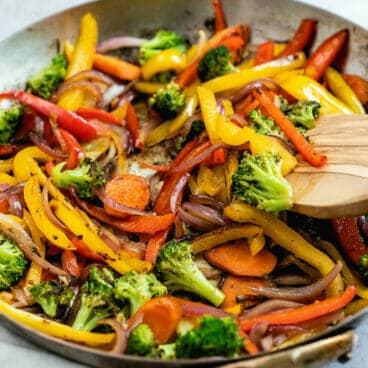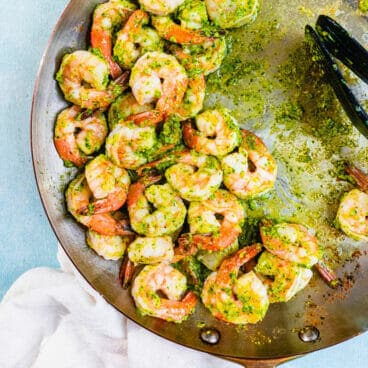This post may include affiliate links; for details, see our disclosure policy.
Here’s how to make the best sauteed vegetables! This is your roadmap to perfectly crisp-tender, brightly colored, and flavor-packed veggies every time.

Looking for a quick and easy side dish? Here’s the fastest way to get colorful veggies to jump onto your plate: the ultimate sautéed vegetables recipe! The good old veggie sauté is often done wrong: it’s soggy or completely bland in flavor.
So why not do a total makeover? These sauteed vegetables are beautifully colored, bursting with flavor and crisp tender in texture: the perfect easy and healthy side dish! Alex and I have made this recipe for our family over and over and it’s always a hit.
Featured reader comment
“Fantastic recipe! Thank you! Using the stainless steel pan to add a little browning was the trick. The timing chart was so perfect.” -Lisa
How to sauté vegetables: the basics
Sautéing is one of the fastest ways to cook vegetables. The word comes from the French word “to jump,” meaning that you’ll need to keep stirring or flipping the pan for the entire cook time.
To sauté you’ll need a good skillet and a fat to use for cooking, typically either olive oil or butter. Sauteing browns the outside of the food, which helps complex flavors to develop. This is called the Maillard reaction, the scientific term for browning food. Here are the basic steps for sauteed vegetables, and the approximate timing for each type of vegetable:

Step 1: Chop the vegetables into bite-sized pieces. Toss them in a bowl with 1 tablespoon olive oil 1 teaspoon dried oregano, ½ teaspoon kosher salt and fresh ground black pepper.

Step 2: Add 1 tablespoon olive oil to a large aluminum or cast iron skillet and heat over medium high heat. Add the vegetables.

Step 3: Cook until crisp tender about 10 to 12 minutes, stirring frequently. Taste to assess doneness. Use the timing in the Sauteed Vegetables Timing Chart below.
Vegetable Timing Chart
Sauteing other types of vegetables? Here’s a chart to reference for approximately how long it takes to saute each type;
- Frozen peas: 2 minutes
- Greens (kale, spinach): 3 minutes
- Mushrooms: 7 minutes
- Broccoli, asparagus: 8 minutes
- Cauliflower, onions: 10 minutes
- Bell peppers: 10 to 12 minutes
- Carrots: 12 minutes
Ingredients for sauteed vegetables
For this sautéed vegetables recipe, we picked vegetables that would cook in approximately the same amount of time. If you choose vegetables with very different cook times, add the longest cooking veggies first and then stagger the start times of the short cooking vegetables.
This recipe we customized so you can cook all the vegetables at once! We also wanted to pick a rainbow of colors to make a nutritious and visually appealing vegan side dish. Here’s what we chose:
- Bell peppers: Sweet and mild bell peppers are loaded with Vitamin C. A medium red bell pepper provides a whopping 169% of your daily vitamin C. (Source)
- Red onion: Red onion adds a savory complimentary flavoring to the sauteed veggies.
- Carrot: Carrot brings color, a dose of Vitamin A, and a sweet flavor. (Source)
- Broccoli: Broccoli adds a splash of green, fiber and protein. We prefer it to cauliflower in a sauté since it cooks faster.
- Olive oil: Olive oil is our preferred oil for sautéing, due to its neutral flavor and high smoke point.
- Seasonings: Kosher salt and a bit of dried oregano to intensify the flavors.

The best pan for sauteed vegetables
You can make sauteed vegetables in any type of pan! You’ll want a large skillet for this recipe, large enough to hold all of the vegetables. In terms of materials, each pan material cooks differently:
- Aluminum or copper: You’ll get the best browning on the edges of the veggies when you use aluminum or copper. This type of skillet is fantastic for sauteing and also searing salmon or scallops.
- Cast iron: Sauteed vegetables also work great in cast iron! It heats well and provides a nice char on the edges.
- Non-stick: You can also sauté in non-stick pans, but keep in mind that the veggies won’t brown as much as with the other surfaces.
Recipes by vegetable
Not looking for mixed vegetables? You can make sauteed vegetables by cooking just one type of vegetable at a time.
Sauteed Peppers & Onions
These peppers and onions are a rainbow of tender, caramelized flavor (or Sauteed Peppers).
Sauteed Broccoli
Here's how to make sauteed broccoli it so it’s lightly browned but perfectly crisp tender and flavorful.
Sauteed Spinach
This fresh and vibrant sauteed spinach is absolutely delicious: it tastes garlicky and irresistible.
Sauteed Carrots
Try these tender, buttery coins, flavored with a hint of herbaceous fresh thyme and chives.
Sauteed Rainbow Chard
Make chard taste incredible by sauteing it! Enhance the flavors by adding pine nuts and Parmesan.
Sauteed Zucchini
Oregano and garlic make a pop of savory flavor, and grated Parmesan cheese takes it over the top.
Sauteed Kale
This sauteed kale is flavored with garlic and cooked until bright green and tender. In a word: delicious!
Sauteed Green Beans
These are the best crisp tender green beans, an easy side dish bursting with flavor!
Sauteed Onions
Tender and golden brown, these onions make anything more rich and savory—and take just 10 minutes.
Variations: ways to season sauteed vegetables
There are lots of ways to add a little flair to this recipe! Use one of our homemade seasoning blends to liven up the flavors. Here’s what we’d recommend:
- Add 1 tablespoon taco seasoning or fajita seasoning to the mix.
- Add Cajun flavor with Cajun seasoning (spicy) or blackened seasoning (mild).
- Try Italian seasoning or Greek seasoning, Mediterranean-style seasoning blends that add an irresistible nuance.
- Old Bay seasoning is an American blend that works well for both seafood and vegetables.
Ways to pair sauteed vegetables
This sauteed vegetables recipe is a highly versatile easy and healthy side dish. It’s flavored simply with olive oil and oregano, so it can go with many different types of cuisines! Here are a few ways to serve these veggies:
- Pasta: Serve alongside broccoli Mac and Cheese, baked rigatoni, zucchini lasagna or white sauce pasta.
- Chicken: These vegetables fit right alongside Greek chicken, chicken piccata, baked chicken thighs, lemon garlic chicken or grilled chicken.
- Salmon or fish: Try pairing with Cajun salmon, baked salmon, pan seared salmon or pesto salmon.
- Shrimp: Add pesto shrimp for an easy meal, or serve with shrimp pasta or shrimp pesto pasta.
Dietary notes
This sauteed vegetables recipe is vegetarian, vegan, plant-based, dairy-free and gluten-free.
Frequently asked questions
Sauteing involves cooking vegetables in a hot pan with a small amount of oil or fat. It creates a tender-crisp texture with vibrant colors, unlike boiling which can lead to mushy vegetables and leached-out nutrients.
Any heavy-bottomed pan or skillet that heats evenly will work. Opt for cast iron, stainless steel, or even a non-stick pan for easier cleanup.
Cut vegetables into similar, bite-sized pieces to ensure even cooking. Consider the vegetable’s natural cooking time – denser vegetables like carrots may need to be cut smaller.
Olive oil is a popular choice for its neutral flavor and high smoke point. However, you can also use avocado oil, peanut oil, or even butter for a richer flavor profile (avoid using butter at very high heats though).
Aromatics like garlic, onion, or shallots sauteed at the beginning add a flavor base. Fresh herbs like thyme or chopped fresh ginger can be added towards the end for a bright touch.

Ultimate Sauteed Vegetables
- Prep Time: 7 minutes
- Cook Time: 13 minutes
- Total Time: 20 minutes
- Yield: 4 1x
Description
Here’s how to make the best sauteed vegetables! This is your roadmap to perfectly crisp-tender, brightly colored, and flavor-packed veggies every time.
Ingredients
- 2 multi-colored bell peppers (we used red and yellow)
- 1 medium red onion
- 1 large carrot
- 1 head broccoli (8 ounces, stem on)
- 2 tablespoons olive oil, divided
- 1 teaspoon dried oregano
- ½ teaspoon kosher salt
- Fresh ground black pepper
Instructions
- Thinly slice the peppers. Slice the onion. Cut the carrot into thin rounds, on the bias. Cut the broccoli into small florets.
- Toss the vegetables in a bowl with 1 tablespoon olive oil and the oregano, kosher salt and plenty of fresh ground black pepper.
- In large skillet*, heat the remaining 1 tablespoon olive oil over medium high heat. Cook for 10 to 12 minutes until tender and lightly charred, stirring occasionally. Taste and add a few pinches of additional salt to taste. Serve immediately.
Notes
*Aluminum, copper, or cast iron pans are best, since they get the best browning. You can also use non-stick, but it won’t have the same level of browning.
Variation: Try adding one of the following seasoning blends to taste: fajita seasoning, taco seasoning, Cajun seasoning, Italian seasoning or Greek seasoning, or Old Bay.
- Category: Side Dish
- Method: Stovetop
- Cuisine: American
- Diet: Vegan
























Wow I love how you well Vanished it
Fantastic recipe! Thank you! Using the stainless steel pan to add a little browning was the trick. The timing chart was so perfect. Much appreciated.
One look at your vegetables and I could tell you all are pros. I do my veg the same exact way all the time. I have been cooking for 40 years and get more complements on this style of vegetable then any other thing. I have a customer that just want sautéed carrots like in your picture with every order. You both do very nice work.
see above
Love the veggie recipe for zucchini.
Trying tonight. Thank you…
Thanks for posting this recipe!